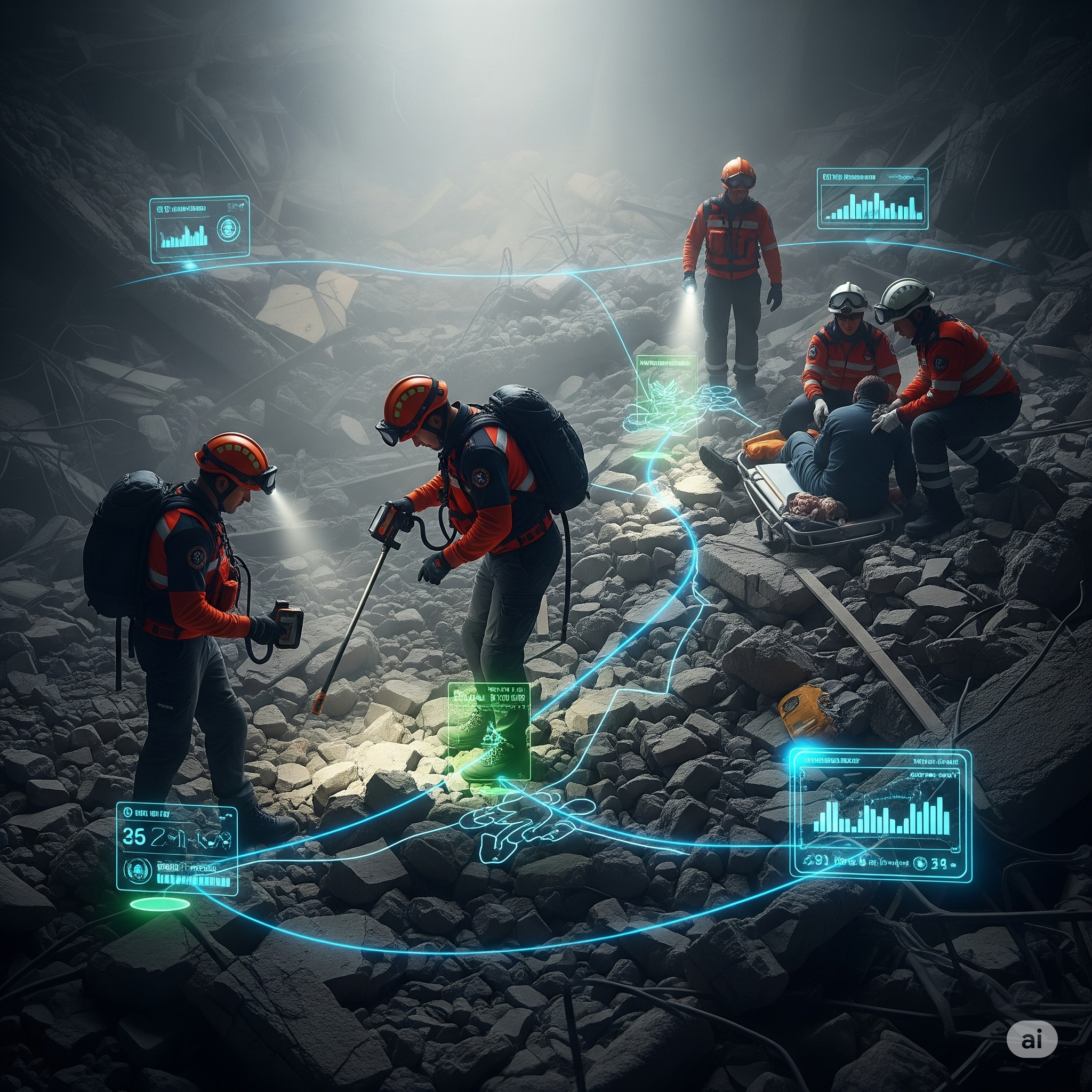Natural disasters and large-scale emergencies are an unfortunate reality of our world. From devastating earthquakes and raging wildfires to unprecedented floods and powerful hurricanes, these events can overwhelm communities and test the limits of human response capabilities. Traditionally, disaster management has relied on established protocols, the bravery of first responders, and the resilience of affected populations. But what if we could anticipate these crises with greater accuracy? What if we could coordinate relief efforts with unparalleled efficiency? This is the transformative promise of AI disaster management.
Artificial intelligence is rapidly emerging as a critical tool in our efforts to prepare for, respond to, and recover from disasters. By harnessing the power of data analysis, machine learning, and predictive modeling, AI disaster management is offering new ways to understand risks, optimize resource allocation, and ultimately save lives. The integration of emergency response AI is not just about faster reactions; it’s about smarter, more informed actions at every stage of the disaster lifecycle. This article will explore the burgeoning field of AI disaster management, examining its current applications, showcasing real-world successes, addressing the inherent challenges, and highlighting the AI tools that are empowering a more resilient future.
From Prediction to Response: Understanding AI Disaster Management
AI disaster management encompasses the use of artificial intelligence technologies across the entire spectrum of disaster preparedness, response, and recovery. It’s about leveraging the ability of AI to process vast amounts of data, identify critical patterns, and generate actionable insights that can enhance our ability to mitigate the impact of catastrophic events. The goal of emergency response AI is to provide decision-makers and first responders with timely and accurate information, enabling them to make more effective choices under pressure.
This isn’t about replacing human intuition and expertise; rather, AI disaster management serves as a powerful augmentation, providing a layer of intelligent analysis that can significantly enhance our capacity to handle crises. From predicting where a hurricane will make landfall to identifying the most vulnerable populations in an earthquake’s aftermath, AI is providing a new level of situational awareness.
The Disaster Management Lifecycle and the Role of AI
The disaster management lifecycle typically includes several key phases, each of which can be significantly enhanced by AI disaster management:
- Mitigation: Reducing the likelihood and potential impact of future disasters. AI can analyze historical data and environmental factors to identify high-risk areas and inform infrastructure planning and building codes.
- Preparedness: Planning and preparing for potential disasters. AI can be used to simulate disaster scenarios, optimize evacuation plans, and pre-position resources based on predictive risk assessments.
- Response: Taking action during and immediately after a disaster.
Emergency response AIcan analyze real-time data from various sources to assess the situation, coordinate rescue efforts, and allocate resources efficiently. - Recovery: Restoring the affected area to its pre-disaster state and building resilience for the future. AI can assist in damage assessment, infrastructure repair planning, and the distribution of aid.
Across all these phases, AI disaster management provides a crucial layer of intelligence, enabling more proactive and effective interventions.
The Data-Driven Advantage in Emergency Response AI
At the heart of AI disaster management lies the power of data. AI algorithms can sift through massive datasets from diverse sources, including:
- Satellite imagery and aerial drones: Providing real-time views of affected areas and infrastructure damage.
- Social media and news feeds: Offering immediate but often unstructured information about the unfolding situation on the ground.
- Sensor networks: Monitoring environmental conditions like rainfall, river levels, and seismic activity.
- Historical disaster records: Providing context and patterns for risk assessment and prediction.
- Communication networks: Tracking connectivity and identifying areas with disrupted services.
Emergency response AI can process this deluge of information much faster and more accurately than humans, identifying critical trends and generating insights that would otherwise be impossible to discern. This data-driven advantage is crucial for making timely and informed decisions during a crisis.
Real-World Impact: AI in Action During Disasters
The application of AI disaster management is no longer a futuristic concept; it’s happening right now, with tangible results in improving response efforts and mitigating the impact of disasters worldwide. Here are some key areas where AI is making a significant difference:
Predictive Analytics for Early Warning Systems
One of the most impactful applications of AI disaster management is in developing more accurate and timely early warning systems. Machine learning algorithms can analyze historical weather data, seismic activity, and other environmental indicators to predict the likelihood and potential severity of impending disasters. This advance warning allows for proactive measures such as evacuations, the mobilization of emergency resources, and the implementation of protective measures, significantly reducing the potential loss of life and property.
AI-Powered Situational Awareness and Damage Assessment
During and immediately after a disaster, obtaining a clear understanding of the situation on the ground is critical. AI disaster management tools can analyze satellite and drone imagery, as well as social media data, to rapidly assess the extent of the damage, identify affected areas, and locate individuals in need of assistance. Emergency response AI can also help prioritize rescue efforts by identifying areas with the highest concentration of damaged structures or distress signals.
Optimizing Resource Allocation and Logistics with AI
Effective disaster response requires the swift and efficient deployment of resources, including personnel, equipment, and supplies. AI algorithms can analyze data on the needs of affected populations, the availability of resources, and transportation networks to optimize logistics and ensure that aid reaches those who need it most, quickly and efficiently. This intelligent allocation of resources can make a significant difference in the effectiveness of relief efforts.
Case Studies in Intelligent Disaster Response
Several organizations and initiatives are at the forefront of leveraging AI disaster management to improve emergency response. These case studies illustrate the practical application and potential impact of these technologies.
Case Study 1: The Red Cross and AI for Humanitarian Aid The Red Cross has been exploring and implementing AI to enhance its humanitarian aid efforts. This includes using AI-powered image analysis to assess damage after disasters, deploying chatbots to provide affected individuals with critical information, and leveraging predictive analytics to anticipate needs and pre-position supplies. Their work demonstrates the potential of AI disaster management to streamline aid delivery and improve support for vulnerable populations.
Case Study 2: Google’s Crisis Response and AI Mapping Google’s Crisis Response team utilizes AI and machine learning to provide timely and accurate information during disasters. This includes AI-powered flood forecasting, the creation of detailed damage maps from satellite imagery, and the aggregation of critical information from various sources to provide a comprehensive overview of the situation. Their efforts showcase how large technology companies can contribute to AI disaster management through their advanced data processing and analytical capabilities. For insights into the broader applications of AI, resources from OpenAI offer a valuable perspective.
Overcoming Challenges and Ethical Considerations in AI Disaster Management
While the potential of AI disaster management is immense, there are also significant challenges and ethical considerations that must be addressed to ensure its responsible and effective implementation.
Data Reliability and Bias in Emergency Response AI
The accuracy and reliability of AI-driven insights in disaster management are heavily dependent on the quality and completeness of the data used to train the algorithms. In emergency situations, data can be fragmented, inconsistent, and even intentionally misleading. Furthermore, biases in the training data can lead to skewed or unfair outcomes. Ensuring data quality, addressing biases, and validating AI-generated insights are critical aspects of responsible AI disaster management.
Coordination and Integration of AI Systems
Disaster response typically involves numerous organizations and agencies operating in complex and rapidly evolving environments. Integrating AI-powered tools and platforms across these diverse entities can be a significant challenge. Ensuring interoperability, data sharing, and effective communication between different AI systems and human responders is crucial for maximizing the benefits of AI disaster management. Platforms like Zapier highlight the importance of seamless integration between different software applications, a principle equally relevant in the context of emergency response.
Ethical Implications and Human Oversight in AI Disaster Management
The use of AI in disaster management raises important ethical considerations, particularly regarding privacy, accountability, and the potential for over-reliance on automated systems. It’s essential to maintain human oversight and control over critical decisions, ensuring that AI serves as a tool to augment human capabilities rather than replace them entirely. Clear ethical guidelines and regulatory frameworks are needed to govern the development and deployment of AI disaster management technologies.
Empowering Response: AI Tools and Workflows for Disaster Management
For organizations and individuals involved in disaster preparedness and response, several AI-powered tools and established workflows can enhance their capabilities.
Key AI-Powered Tools for Disaster Response
- AI-powered GIS and Mapping Platforms: Tools that integrate AI for rapid analysis of geospatial data, damage assessment, and risk mapping.
- NLP-based Crisis Information Extraction: Systems that use natural language processing to analyze social media, news reports, and other text-based data to extract critical information and identify emerging needs.
- Predictive Analytics Platforms: Software that leverages machine learning to forecast potential disasters, assess risks, and optimize resource allocation.
- AI-driven Communication and Alert Systems: Platforms that use AI to disseminate timely and targeted information to affected populations and response teams.
A Practical Workflow for Integrating AI in Disaster Response
- Identify Critical Information Needs: Determine the key information required for effective decision-making at each stage of the disaster lifecycle.
- Leverage Existing Data Sources: Identify and access relevant data sources, including satellite imagery, sensor networks, social media APIs, and historical records.
- Select Appropriate AI Tools: Choose AI-powered tools that can effectively analyze the identified data and generate the required insights (e.g., using an AI-powered mapping tool for damage assessment).
- Integrate AI Insights into Response Plans: Develop protocols and workflows that incorporate AI-generated information into existing emergency response procedures.
- Train Personnel on AI-Powered Tools: Ensure that response teams are properly trained on how to use and interpret the output of AI-powered systems.
- Continuously Evaluate and Improve: Regularly assess the effectiveness of AI integration in disaster response and make adjustments based on lessons learned and technological advancements.
- AI Design Thinking Just Got a Superpower
The Future of AI in Disaster Management: Building Resilience for Tomorrow
The field of AI disaster management is poised for significant growth and innovation in the years to come. As AI technologies continue to evolve and become more sophisticated, we can expect to see even more powerful and versatile applications in disaster preparedness, response, and recovery. The integration of AI with other emerging technologies, such as robotics and the Internet of Things, holds immense potential for creating more resilient and adaptive communities. The ongoing development of emergency response AI will be crucial in our collective efforts to mitigate the devastating impacts of disasters and build a safer future for all.
By embracing the power of AI disaster management responsibly and ethically, we can significantly enhance our ability to protect lives, safeguard communities, and build a more resilient world in the face of increasing natural and human-caused disasters.



